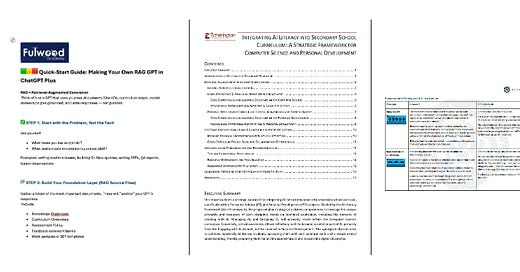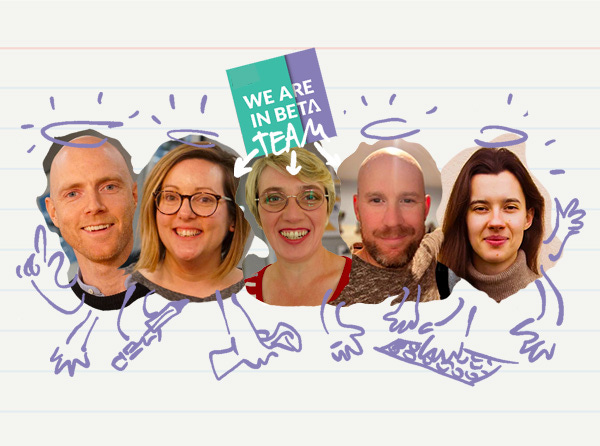Learning new things on your own take can what feels like for ever.
When you’re not even sure how those things can help you in the first place, the chances are you might not get started at all.
In both cases, seeing how others have tackled specific challenges through case studies is super helpful.
This has never been more true with AI in schools right now.
If you’re working towards more consistent practice, more AI literate staff and students, integrated pedagogy and better prompting and resources, this week’s highlights from the We Are In Beta Community can help.
We - schools - Are In Beta - always learning (when we learn from others, who can show you exactly how they do it).
This week
🧩 how to make and train custom GPTs to achieve staff consistency
🧠 how to develop AI literacy to avoid over reliance and ensure student safety
🧑🏫 how use pedagogy to guide AI and not the other way around
⛓️ how use chain of thought prompting to improve the quality of AI generated resources
Four lessons from AI leaders in schools
AI across the curriculum was a prominent them at Curriculum Thinking Week 2025 (CTW25).
To help you decide which sessions to access first, I’ve pulled out lessons from four of the sessions about AI below.
But before I share them, please note that talks and resources are now only available on demand to paying members and speakers who contributed the conference.
That said, we appreciate how busy this week has been, so if you're not a speaker, or a paying member of the Curriculum Thinkers Community, and want to access them beyond that, let us know here.
So what did I learn from AI leaders this week?
1. 🧩 Build and train GPTs around real school problems to save time and improve consistency
Chat GPT is incredible. But the quality of you get out, depends entirely on the quality of what you put in.
This is a big problem if you are looking to create consistency of staff practice and student experience.
Especially, if you have lots of colleagues, with different levels of AI experience doing jobs that take a lot of time like:
writing up lesson visits
designing and writing booklets and
adapting lessons and resources for EAL students.
Custom GPTs can solve real school improvement problems like these when designed with clear goals, pedagogy, and safe use in mind.
Lee McLinden (DHT: Curriculum, T&L, Fulwood Academy) has built and trained a series of custom GPTs, which he has shared here.
Three practical steps he recommends include:
Prototype with a clear purpose:
“Consider: What is the problem you're trying to solve? What are you spending too much time doing? Where is the issue that you need to either automate or reduce workflow or centralise?”
Train your GPT with school-specific resources:
“Think about all of the foundational documents... What existing policies, research, curriculum maps, knowledge organisers have you got that you want the brain to learn?”
Design smart prompts to guide output:
“Creates a six-question do it now quiz on topic X... First four questions should be quick wins... Final two should encourage challenge... Use multiple formats.”
To see how Lee does it and access a downloadable step-by-step guide…
While building GPTs to streamline tasks is powerful, we also have to ask: are students ready for this world of AI?
Are we teaching them to use it wisely or become dependent on it?
2. 🧠 Teach AI literacy to avoid over reliance and ensure student safety
Students are using AI more often than teachers realise. For homework, revision and for emotional support.
But without guidance, this could lead to AI dependence, what’s called ‘cognitive outsourcing’ and potentially put them in harm’s way.
AI literacy is essential to avoid over dependence and to equip students and staff for safe, effective use of AI.
Andy Pilbury (Senior Deputy Headteacher (Raising Standards), Tytherington School) has been comparing staff and student AI use and laying the foundations for a brand new AI literacy programme.
Three practical steps he recommends include:
Survey students and staff to establish baseline use and understanding:
“I made use of separate pupil and staff surveys and smaller student voice exercises in order to understand what was going on. Teachers underestimated student use and ability”
Use an established framework to plan AI literacy curriculum:
“The OECD's AI Literacy Framework... provides an excellent starting point... including clear and appropriate competencies and suitable suggested learning activities to build into an AI literacy curriculum for students.”
Embed AI literacy into existing subject areas:
“18 of the 22 competencies... delivered through Computer Science, whereas 12... delivered through personal development. In personal development we will focus on the ‘why’ and in Computer Science we will teach the ‘how.”
To access to the surprising survey results and the full list of frameworks they’re’ using…
Teaching students about AI is crucial - but what about us, as teachers?
How do we use AI without losing sight of the pedagogy that underpins good learning?
3. 🧑🏫 Use your pedagogical expertise to guide AI, not the other way around
AI can generate content quickly — but without thoughtful input, it risks being generic, inaccurate, or misaligned with how students actually learn. Tech can distract from learning when it isn’t anchored in pedagogy.
AI should be guided by pedagogy; teachers remain the experts in designing effective, evidence-informed instruction.
Jo Hughes is Group Director at Berkhamsted Schools Groups, has been embedding Rosenshine’s Principles into their AI practice.
Three practical steps she recommends include:
Use AI tools to support Rosenshine’s principles of instruction:
“We can actually use AI to generate resources that are in line with these principles and therefore can enhance our students’ learning.”
Be specific in your AI prompts about role, purpose, and structure:
“Within my prompt, I've told it its role... given it the context of the specification... attached the assessment criteria.”
Review and customise AI outputs to match your learners’ needs:
“Once your quiz is generated... check it for accuracy... it might take a couple additional prompts to get it exactly where you want it.”
To see how she does it and access resources that link Rosenshine’s principles, to research and example prompts…
Grounding AI in pedagogy is key. But there’s an even more powerful technique to get the best out of AI - one that makes it think like a teacher…
4. ⛓️ Use chain-of-thought prompting to improve the quality of AI-generated resources
AI can produce bland or inaccurate lesson content if you don’t guide its thinking. Think: multiple choice quizzes that don’t reflect exam specs or don’t have plausible distractors.
Without structured reasoning, it won’t reflect how teachers scaffold, differentiate, or address misconceptions.
‘Chain-of-thought’ prompting improves the pedagogical quality of AI-generated resources by encouraging structured reasoning.
Jack Weston (Assistant Headteacher, Bow School) has been improving the quality resources, which he has shared here.
Three practical steps he recommends include:
Use chain-of-thought reasoning to improve resource quality:
“Ask it to think about the misconceptions... the sequence of learning... plausible distractors... difficulty progression.”
Specify curriculum and exam board context in your prompts:
“Be specific that you are working with students in the UK education system. I would also include the year group.”
Create realistic and challenging student activities:
“Use chain-of-thought prompting to create an error example… highlight the common errors… explain why they’re wrong… provide an improved example.”
If you want to see how Jack does it and how much difference it makes to the quality of resources…
On a personal note.
I am always humbled by the generosity and practicality of the content our members share at our conferences.
I am also hugely grateful for them. As are those who come along to learn from their ideas.
So, from the bottom of my heart, a HUGE thank you to:
Everyone who attended Curriculum Thinking Week 2025.
Everyone who commented under talks and fed back on sessions - the speakers really appreciate it.
All the senior leaders in schools who nominated and supported speakers.
All brilliant the speakers themselves - such incredible generosity.
The We Are In Beta team for their work over the last 4 months to make CTW25 happen: Kasia, Fran and Tom.
None of it would be possible without your belief in collaboration and sharing with (and for) the community.
You make it a special place to be.
If you missed it, get some extended access here.
Thanks for reading.
@NiallAlcock and the We Are In Beta team
Sent this by a friend?
📱 Get 20,371 school leaders and teachers in your pocket - download We Are In Beta.
🚀 Looking for a new role? Get updates about specific jobs you’re looking for before anyone else.
🆕 New here? Catch up with previous editions, podcasts and webinars via the archive.




